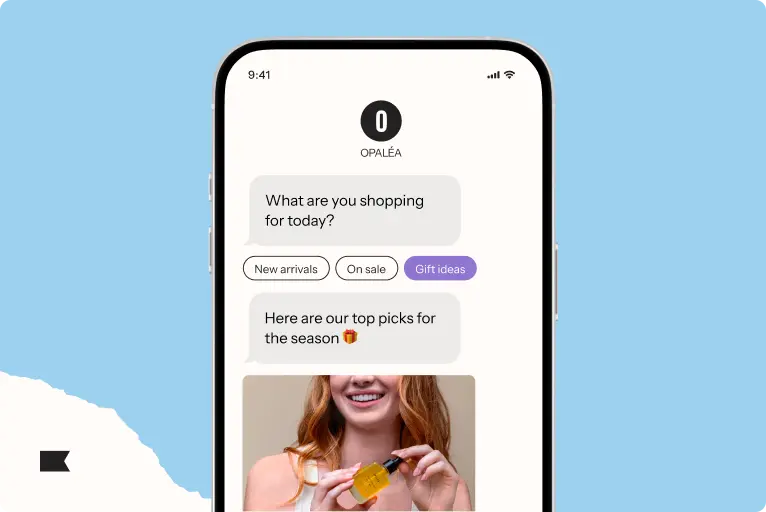Marketing executives are done with data siloing. Effective SMS campaigns depend on integration

When brands focus on their owned marketing strategy, email seems to get all the love.
But the truth is, 30% of all ecommerce brands and over half of businesses that make $20M+ in annual revenue are using SMS, too.
Unlike paid advertising, “owned marketing” refers to marketing channels where you have complete control over how your brand is represented—like email and SMS.
Similar to email, effective SMS marketing relies on a fine-tuned audience targeting strategy to see results. But when we surveyed ecommerce executives for their input on personalized marketing at scale, they identified a glaring obstacle: data siloing.
Your brand likely has access to vast quantities of data spread over multiple platforms. Platform A might have a robust customer dataset with the ability to personalize emails. Platform B might have a limited customer dataset with the ability to send text messages, but not email.
And information about additional customer interactions like support tickets might live in a completely different system.
This is why brands see lackluster results with SMS: They can’t take advantage of the customer data gathered via email and their website, so they can’t target the right people with text messages.
When they integrate their customer data with email and SMS in one platform, however, targeting, testing, and message refinement possibilities open up—and they can start sending the right text messages to the right people, rather than blasting their whole list.
Here are 3 real-life examples from Klaviyo customers that have gotten the most out of their audience data to send targeted SMS marketing campaigns that convert.
1. Fast Growing Trees optimizes their SMS strategy with A/B testing and increases click rate 10x
Fast Growing Trees was looking to grow their SMS marketing channel. But first, they wanted to figure out a more efficient way to use it.
The team was sending 4-5 MMS campaigns (3x the cost of plain-text SMS) per week to their 180-day engaged segment, informed by data from their email campaigns.
The team decided to use Klaviyo’s powerful built-in A/B testing tools to test SMS vs. MMS sends—and SMS drove 10x the expected click rate for a third of the price.
Next, they started experimenting with even more SMS optimization strategies, such as:
- Focusing SMS campaigns on their 60-day engaged segment
- Cutting the frequency of their SMS campaigns, reserving them for urgent, last-chance messaging
- Using a hybrid email and SMS flow to celebrate a customer’s first purchase and encourage them to buy again
After the strategy shift at the end of June 2023, Fast Growing Trees grew revenue per SMS message 35% QoQ.
2. Otherland uses multi-channel segments for deeper customer research
Artisanal candle brand Otherland hasn’t allocated budget to SMS list growth, but they’ve still managed to grow their list to a point where it drives an “astounding” quantity of orders.
Beyond revenue, though, the brand uses SMS in combination with consolidated customer data to learn more about their audience.
With their SMS channel connected to their customer data platform, the brand is able to segment subscribers based on:
- Answers to Otherland’s scent quiz, the results of which port straight to each respondent’s customer profile
- Frequent clicks without buying on their Matchpoint candle campaigns
Now that Otherland knows so much about their subscribers’ preferences and buying intent, they can send them more relevant messages via SMS—something that wouldn’t be possible without data and channel integration.
“I love Klaviyo segmentation, and how you can filter on so many variables and conditions at once,” says Otherland’s brand manager Jenna Catalon Songer. “I can find the exact segment of subscribers I’m looking for.”
3. Linksoul integrates texts into existing email flows and boosts flow revenue 82%
Linksoul was an early adopter of SMS marketing, and their customers took to it immediately: Just weeks after launch, they had 20K subscribers.
There was just one problem: They couldn’t segment their SMS sends.
A lot of the customer data Linksoul wanted to use for segmentation was in Klaviyo, which they used for email—but not for SMS.
After they moved their SMS data to Klaviyo, which already housed their customer data from email and sign-up forms, they integrated texts into existing email flows—and boosted flow revenue 82%.
“Now we’ve got a text in almost all of our flows, and our overall flow revenue increased 82% last year,” says Linksoul’s ecommerce manager Brandi Cantrell. “The majority of that flow revenue came from SMS.”
Targeted SMS marketing requires a unified approach
It takes, on average, 6 separate touchpoints for a consumer to purchase a product. That customer journey is messy, non-linear, and difficult to track without a unified marketing platform.
When brands centralize customer data and all their owned marketing channels, they usually see a few key benefits right away:
- More revenue from SMS follow-ups
- One complete data profile for every customer
- Segmentation and personalization that lead to more revenue
- Accurate reporting and channel attribution
- More reviews from happy customers at the right time
If you’re using different platforms for email, SMS, and customer reviews, you aren’t using your customer data to its full potential.
Eliminate data siloing, allocate your resources well, and grow your business with Klaviyo as your marketing command center. Learn more about what a consolidated marketing platform can do for your business.

Related content

Looking for the best SMS marketing tools? See the top 3 platforms for 2026 and learn how to choose the right one for segmentation, automation, and two-way messaging

Marketers are right to be cautious right now. The Texas settlement has sparked more questions than clarity—but that’s exactly why taking a compliance-first approach still matters.

Google’s RCS Roadshow and Klaviyo are shaping the future of mobile marketing with AI-powered personalization and trusted, interactive messaging.